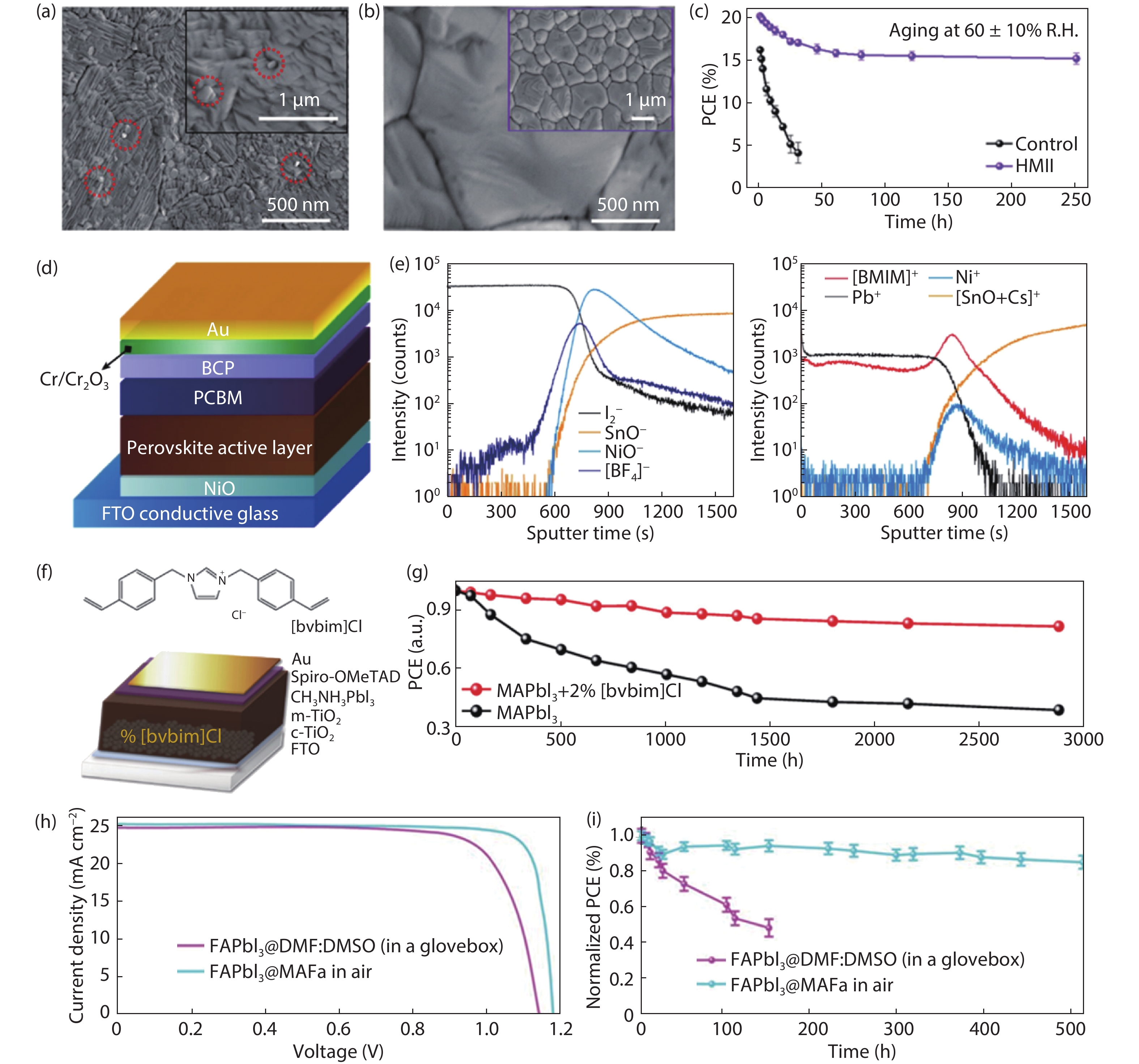| Citation: |
Wensi Cai, Zhigang Zang, Liming Ding. Ionic liquids in perovskite solar cells[J]. Journal of Semiconductors, 2021, 42(8): 080201. doi: 10.1088/1674-4926/42/8/080201
W S Cai, Z G Zang, L M Ding, Ionic liquids in perovskite solar cells[J]. J. Semicond., 2021, 42(8): 080201. doi: 10.1088/1674-4926/42/8/080201.
Export: BibTex EndNote
|
-
References
[1] Min H, Kim M, Lee S U, et al. Efficient, stable solar cells by using inherent bandgap of alpha-phase formamidinium lead iodide. Science, 2019, 366, 749 doi: 10.1126/science.aay7044[2] Zhao X F, Tan Z K. Large-area near-infrared perovskite light-emitting diodes. Nat Photonics, 2020, 14, 215 doi: 10.1038/s41566-019-0559-3[3] Jeong M, Choi I W, Go E M, et al. Stable perovskite solar cells with efficiency exceeding 24.8% and 0.3-V voltage loss. Science, 2020, 369, 1615 doi: 10.1126/science.abb7167[4] Yoo J J, Seo G, Chua M R, et al. Efficient perovskite solar cells via improved carrier management. Nature, 2021, 590, 587 doi: 10.1038/s41586-021-03285-w[5] Kim G, Min H, Lee K S, et al. Impact of strain relaxation on performance of α-formamidinium lead iodide perovskite solar cells. Science, 2020, 370, 108 doi: 10.1126/science.abc4417[6] Niu T, Chao L, Gao W, et al. Ionic liquids-enabled efficient and stable perovskite photovoltaics: progress and challenges. ACS Energy Lett, 2021, 1453 doi: 10.1021/acsenergylett.0c02696[7] Ghosh S, Singh T. Role of ionic liquids in organic-inorganic metal halide perovskite solar cells efficiency and stability. Nano Energy, 2019, 63, 103828 doi: 10.1016/j.nanoen.2019.06.024[8] Zhou X, Hu M, Liu C, et al. Synergistic effects of multiple functional ionic liquid-treated PEDOT: PSS and less-ion-defects S-acetylthiocholine chloride-passivated perovskite surface enabling stable and hysteresis-free inverted perovskite solar cells with conversion efficiency over 20%. Nano Energy, 2019, 63, 103866 doi: 10.1016/j.nanoen.2019.103866[9] Noel N K, Habisreutinger S N, Wenger B, et al. Elucidating the role of a tetrafluoroborate-based ionic liquid at the n-type oxide/perovskite interface. Adv Energy Mater, 2020, 10, 1903231 doi: 10.1002/aenm.201903231[10] Xia Y, Ran C, Chen Y, et al. Management of perovskite intermediates for highly efficient inverted planar heterojunction perovskite solar cells. J Mater Chem A, 2017, 5, 3193 doi: 10.1039/C6TA09554B[11] Liu L, Tang Z, Xin C, et al. Acetate anion assisted crystal orientation reconstruction in organic–inorganic lead halide perovskite. ACS Appl Energy Mater, 2018, 1, 2730 doi: 10.1021/acsaem.8b00400[12] Akin S, Akman E, Sonmezoglu S. FAPbI3-based perovskite solar cells employing hexyl-based ionic liquid with an efficiency over 20% and excellent long-term stability. Adv Funct Mater, 2020, 30, 2002964 doi: 10.1002/adfm.202002964[13] Bai S, Da P, Li C, et al. Planar perovskite solar cells with long-term stability using ionic liquid additives. Nature, 2019, 571, 245 doi: 10.1038/s41586-019-1357-2[14] Xia R, Gao X X, Zhang Y, et al. An efficient approach to fabricate air-stable perovskite solar cells via addition of a self-polymerizing ionic liquid. Adv Mater, 2020, 32, 2003801 doi: 10.1002/adma.202003801[15] Hui W, Chao L, Lu H, et al. Stabilizing black-phase formamidinium perovskite formation at room temperature and high humidity. Science, 2021, 371, 1359 doi: 10.1126/science.abf7652 -
Proportional views






 DownLoad:
DownLoad:














